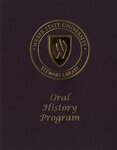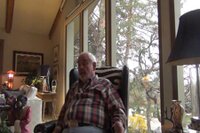| Title |
001_Lovell, Rick OH13_009 |
| Contributors |
Lovell, Rick, Interviewee; Lougy, Deanna, Interviewer; Catlin, Cheryl, Technician |
| Image Captions |
Rick Lovell |
| Description |
The following includes the transcript and a video clip from an oral history interview with Rick Lovell. |
| Biographical/Historical Note |
The Ogden Union Stockyard was a key fixture in the largest livestock market west of Denver during its heyday from 1916 to 1971. The activities at the yard brought Ogden national attention as a livestock center. The rise of the livestock shows, auctions, etc. at the site spurred the local and regional livestock industry, thereby physically shaping the development of the agricultural landscape both near and far. This collection documents the history through photographs, newspaper articles, and oral histories. |
| Subject |
Ogden (Utah); Stockyards; Buildings--1916-1971; Architecture--History; Business enterprises |
| Digital Publisher |
Stewart Library, Weber State University, Ogden, Utah, USA |
| Date |
2015 |
| Date Digital |
2015 |
| Temporal Coverage |
Ogden, Weber County, Utah, United States, http://sws.geonames.org/5779206, 41.223, -111.97383 |
| Medium |
oral histories (literary genre) |
| Spatial Coverage |
Ogden, Weber County, Utah, United States, http://sws.geonames.org/11788968, 41.22809, -111.96766 |
| Type |
Image/StillImage; Image/MovingImage; Text |
| Conversion Specifications |
Filmed using a Sony HDR-CX430V digital video camera. Sound was recorded with a Sony ECM-AW3(T) bluetooth microphone. Transcribed using WAVpedal 5 Copyrighted by The Programmers' Consortium Inc. Digitally reformatted using Adobe Acrobat Xl Pro. |
| Language |
eng |
| Has Format Of |
application/pdf; video/mp4 |
| Rights |
Materials may be used for non-profit and educational purposes; please credit University Archives, Stewart Library, Weber State University. |
| Source |
Lovell, Rick OH13_009; Weber State University, Stewart Library, University Archives |
| Format |
application/pdf; video/mp4 |
| ARK |
ark:/87278/s6rcbv0m |
| Setname |
wsu_osy_oh |
| ID |
79290 |
| Reference URL |
https://digital.weber.edu/ark:/87278/s6rcbv0m |
| Title |
Lovell, Rick OH13_009 |
| Contributors |
Lovell, Rick, Interviewee; Lougy, Deanna, Interviewer; Catlin, Cheryl, Technician |
| Image Captions |
Rick Lovell |
| Description |
The following is an oral history interview with Rick Lovell, conducted by Deanna Lougy on March 24, 2015. Lovell discusses his knowledge and experiences with the historic Ogden Union Stockyards. Also present is Cheryl Keflen, the videographer. |
| Biographical/Historical Note |
The Ogden Union Stockyard was a key fixture in the largest livestock market west of Denver during its heyday from 1916 to 1971. The activities at the yard brought Ogden national attention as a livestock center. The rise of the livestock shows, auctions, etc. at the site spurred the local and regional livestock industry, thereby physically shaping the development of the agricultural landscape both near and far. This collection documents the history through photographs, newspaper articles, and oral histories. |
| Subject |
Ogden (Utah); Stockyards; Buildings--1916-1971; Architecture--History; Business enterprises |
| Digital Publisher |
Stewart Library, Weber State University |
| Date |
2015 |
| Date Digital |
2015 |
| Temporal Coverage |
Ogden, Weber County, Utah, United States, http://sws.geonames.org/5779206, 41.223, -111.97383 |
| Item Size |
14p.; 29cm.; 2 bound transcripts; 4 file folders. 1 video disc: digital; 4 3/4 in. |
| Spatial Coverage |
Ogden, Weber County, Utah, United States, http://sws.geonames.org/11788968, 41.22809, -111.96766 |
| Type |
Text |
| Conversion Specifications |
Filmed using a Sony HDR-CX430V digital video camera. Sound was recorded with a Sony ECM-AW3(T) bluetooth microphone. Transcribed using WAVpedal 5 Copyrighted by The Programmers' Consortium Inc. Digitally reformatted using Adobe Acrobat Xl Pro. |
| Language |
eng |
| Has Format Of |
application/pdf |
| Rights |
Materials may be used for non-profit and educational purposes; please credit University Archives, Stewart Library, Weber State University. |
| Source |
Lovell, Rick OH13_009; Weber State University, Stewart Library, University Archives |
| Format |
application/pdf |
| Setname |
wsu_osy_oh |
| ID |
79313 |
| Reference URL |
https://digital.weber.edu/ark:/87278/s6rcbv0m/79313 |





